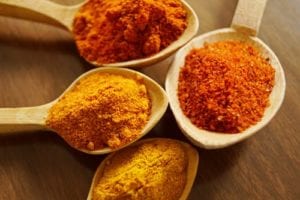Written by Joyce Smith, BS. In an in vitro alpha-coronavirus model, curcumin not only inhibited the proliferation of the transmissible gastroenteritis virus (TGEV) but was also able to deactivate and destroy it.
 Emerging coronaviruses (CoVs), belonging to the family Coronaviridae 1, are enveloped RNA viruses that have no currently available or approved effective treatment and pose a worldwide threat to both humans and animals. TGRV, a member of the alpha-genus Coronavirus 2, causes a disease called transmissible gastroenteritis in piglets 3, which is characterized by diarrhea, severe dehydration and death. TGEV is highly infectious and is invariably fatal in piglets younger than two weeks of age, thus posing a major threat to the global swine industry. Presently, vaccinating is the primary method of preventing TGEV infection; however, the commercially available vaccines have been ineffective in preventing viral spread 4,5, thus highlighting the need for a treatment that offers complete disease protection and control.
Emerging coronaviruses (CoVs), belonging to the family Coronaviridae 1, are enveloped RNA viruses that have no currently available or approved effective treatment and pose a worldwide threat to both humans and animals. TGRV, a member of the alpha-genus Coronavirus 2, causes a disease called transmissible gastroenteritis in piglets 3, which is characterized by diarrhea, severe dehydration and death. TGEV is highly infectious and is invariably fatal in piglets younger than two weeks of age, thus posing a major threat to the global swine industry. Presently, vaccinating is the primary method of preventing TGEV infection; however, the commercially available vaccines have been ineffective in preventing viral spread 4,5, thus highlighting the need for a treatment that offers complete disease protection and control.
Previous studies have shown curcumin’s ability to inhibit the replication of certain types of virus, including the Zika, hepatitis B, chikungunya and dengue viruses 6,7 . Curcumin has also been studied for its several significant biological effects, including antibacterial, anti-inflammatory, antifungal, antiparasitic, antiviral and antitumor activities 8. To date the polyphenolic potency of curcumin against TGEV has not been tested, thus challenging the research team of Li and colleagues to pursue curcumin, with its availability and minimal side effects, as a potential agent against this challenging virus.
To investigate the antiviral properties of curcumin, the research team 9 first treated experimental porcine kidney (PK-15) cells with various concentrations of curcumin to determine the most effective dosage range before attempting to infect them with TGEV. Concentrations above 50um were eliminated. Using various concentrations of curcumin (0, 10, 20, 30, and 40 um) on treatment groups and DMSO on control groups of infected PK cells, enabled the team to perform in vitro anti-viral, verucidal, attachment, and adsorption, penetration and replication assays. The differences seen between the curcumin-treated groups and the DMSO-treated groups were significant. Compared to the control groups, the curcumin-treated groups demonstrated curcumin’s low toxicity, and its antiviral activity in a significantly increasing dose-dependent manner, its direct veridical abilities in a dose-temperature- and time-dependent manner, and its ability to reduce TGEV adsorption and replication within the PK-15 cells.
The infection of cells by a virus can be divided into stages: adsorption, penetration, replication and release 3. Collectively, study results indicate that curcumin has complex mechanisms for regulating TGEV infection and its impact on TGEV was demonstrated in several ways. Researchers suggest that its strong antiviral activity allowed it to directly inactivate the TGEV virus and to inhibit its adsorption into the cell by penetrating the viral envelope to “inactivate” the virus. It was also able to immediately destroy the virus before it could infect the cell by modifying the metabolism of the PK-cells so that entry of the virus and its replication within the cell was inhibited. Lastly curcumin was shown to be safe at high doses, thus making it a potential effective drug for preventing TGEV infection. Researchers recommend additional studies to evaluate its inhibitory abilities in vivo.
Source: Li, Maoming, Jing Wang, Yinchuan Liu, Xiang Luo, Keqiang Lei, and Lila Xie. “Antiviral and virucidal effects of curcumin on transmissible gastroenteritis virus in vitro.” Journal of General Virology (2020): jgv001466.
© 2020 The Authors
Click here to read the full text study.
Posted August 11, 2020.
Joyce Smith, BS, is a degreed laboratory technologist. She received her bachelor of arts with a major in Chemistry and a minor in Biology from the University of Saskatchewan and her internship through the University of Saskatchewan College of Medicine and the Royal University Hospital in Saskatoon, Saskatchewan. She currently resides in Bloomingdale, IL.
References:
- Perlman S. Research Driven by Curiosity: The Journey from Basic Molecular Biology and Virology to Studies of Human Pathogenic Coronaviruses. PLoS pathogens. 2015;11(7):e1005023.
- Payne S. Chapter 17-Family Coronaviridae Viruses. In: Academic Press; 2017.
- Brian DA, Baric RS. Coronavirus genome structure and replication. Current topics in microbiology and immunology. 2005;287:1-30.
- Ren X, Meng F, Yin J, et al. Action mechanisms of lithium chloride on cell infection by transmissible gastroenteritis coronavirus. PLoS One. 2011;6(5):e18669.
- Zou H, Zarlenga DS, Sestak K, Suo S, Ren X. Transmissible gastroenteritis virus: identification of M protein-binding peptide ligands with antiviral and diagnostic potential. Antiviral Res. 2013;99(3):383-390.
- Hesari A, Ghasemi F, Salarinia R, Biglari H, Tabar Molla Hassan A et al. Effects of curcumin on NF-κB, AP-1, and Wnt/β- catenin signaling pathway in hepatitis B virus infection. J CellBiochem 2018;119:7898–7904.
- Mounce BC, Cesaro T, Carrau L, Vallet T, Vignuzzi M. Curcumin inhibits Zika and Chikungunya virus infection by inhibiting cell binding. Antiviral Res 2017;142:148–157.
- Moghadamtousi SZ, Kadir HA, Hassandarvish P, Tajik H, Abubakar S, Zandi K. A review on antibacterial, antiviral, and antifungal activity of curcumin. Biomed Res Int. 2014;2014:186864
- Li, Maoming, Jing Wang, Yinchuan Liu, Xiang Luo, Keqiang Lei, and Lila Xie. “Antiviral and virucidal effects of curcumin on transmissible gastroenteritis virus in vitro.” Journal of General Virology (2020): jgv001466.
